Construction projects, no matter how well-planned, are often vulnerable to unforeseen hazards that can cause significant delays, inflate costs, and even jeopardize the entire project. While careful planning and diligent management reduce risks, some challenges can emerge unexpectedly. Understanding these potential hazards is crucial for staying ahead and ensuring a smooth construction process. Unforeseen hazards that could derail your construction project can be costly. Work with construction experts through construction management services for best results.
In this article, we’ll explore several unforeseen hazards that can derail your construction project and how to manage them effectively to minimize their impact.
Weather-Related Delays
Even with the most accurate weather forecasts, the unpredictability of Mother Nature can disrupt construction schedules. Severe weather events such as heavy rain, snow, windstorms, or extreme heat can halt construction for days or even weeks. Inclement weather can lead to damaged materials, unsafe working conditions, and extended project timelines.
How to manage it:
- Build a buffer into your project schedule to account for potential weather delays.
- Invest in weather-resistant materials and equipment to protect your project from unexpected conditions.
- Use technology like weather monitoring apps to track real-time conditions and adjust plans accordingly.
- Plan for off-site work on bad weather days to keep productivity going, such as prefabricating components or organizing materials.
Site Condition Surprises
Every construction project begins with site preparation, but unexpected site conditions can throw a wrench into the works. Problems like unstable soil, underground utilities, or contaminated land can cause delays and increase costs. Often, these issues aren’t detected until excavation or foundation work begins.
How to manage it:
- Conduct thorough site investigations before breaking ground, including soil testing, environmental assessments, and utility surveys.
- Prepare a contingency plan in case site conditions require adjustments to the design or construction process.
- Budget for unexpected site-related issues to avoid being blindsided by additional costs.
Regulatory and Permit Delays
Construction projects require multiple permits and approvals, and any delay in obtaining them can stall the entire project. Zoning changes, building code updates, or unforeseen regulatory issues can create hurdles, especially if the project’s scope isn’t fully aligned with local regulations.
How to manage it:
- Start the permitting process as early as possible to allow ample time for approvals.
- Work closely with local authorities to understand all the necessary regulations and permits required for your project.
- Keep communication open with regulators to address any potential issues before they become roadblocks.
Material Shortages and Price Increases
Global supply chain disruptions, natural disasters, or economic shifts can lead to material shortages or sudden price increases. These issues can significantly impact your budget and timeline, especially if critical materials like steel, concrete, or lumber become scarce or too expensive.
How to manage it:
- Build flexibility into your material choices by identifying alternative suppliers or materials that can substitute without compromising quality.
- Purchase key materials early in the project to lock in prices and ensure availability.
- Establish relationships with multiple suppliers to ensure backup options if your primary source experiences delays.
Labor Shortages and Turnover
Skilled labor is essential to any construction project, but labor shortages are an ongoing challenge in the industry. Unexpected worker turnover, strikes, or general labor scarcity can delay the project and drive up labor costs. Moreover, inexperienced or underqualified workers can lead to poor-quality work or accidents.
How to manage it:
- Partner with reputable subcontractors and staffing agencies to ensure access to skilled labor.
- Offer competitive wages and benefits to attract and retain qualified workers.
- Provide training programs to improve the skills of your labor force and reduce turnover rates.
- Cross-train workers on multiple tasks to create flexibility in your labor pool.
Equipment Failures
Construction relies heavily on machinery and equipment. An unexpected breakdown of crucial machinery like cranes, excavators, or concrete mixers can result in significant project delays. Equipment failures can also lead to increased repair costs and missed deadlines.
How to manage it:
- Implement regular maintenance and inspections of all construction equipment to prevent breakdowns.
- Rent or lease backup equipment in case primary machinery fails, ensuring the project doesn’t come to a complete halt.
- Budget for potential equipment repairs and allocate time in the schedule for maintenance tasks.
Design Changes and Scope Creep
Even the most carefully planned designs can change during the construction process. Clients may request modifications, or the project may face unexpected design challenges that require adjustments. When changes are introduced without proper planning, they can lead to increased costs, extended timelines, and rework.
How to manage it:
- Establish clear communication with clients and stakeholders to define the project scope upfront and avoid frequent changes.
- Implement a formal change order process to document and approve any changes before they are made.
- Ensure that all design changes are evaluated for their impact on the schedule, budget, and overall project.
Safety Incidents
Construction sites are inherently dangerous, and accidents can happen despite safety protocols. Injuries, equipment damage, or structural failures can halt progress and lead to costly investigations, fines, or legal action.
How to manage it:
- Create a strong safety culture on the site by implementing strict safety protocols and regular safety training for workers.
- Conduct daily site inspections to identify potential hazards and take corrective action immediately.
- Ensure that all workers have access to and use the necessary personal protective equipment (PPE).
- Review your site’s safety procedures regularly and make adjustments based on industry best practices.
Legal Disputes
Disputes between contractors, clients, suppliers, or subcontractors can arise at any point during a construction project. Contract disputes, disagreements over project scope, or payment issues can lead to costly legal battles and delays.
How to manage it:
- Draft clear, detailed contracts with all parties to define responsibilities, deliverables, and payment terms.
- Use alternative dispute resolution (ADR) methods like mediation or arbitration to settle conflicts quickly and without court involvement.
- Maintain open communication with all stakeholders to address issues as soon as they arise.
Environmental Factors and Natural Disasters
Natural disasters such as earthquakes, floods, or hurricanes can cause sudden and significant damage to construction sites. These unforeseen events can lead to damaged equipment, ruined materials, and the need to rebuild parts of the project.
How to manage it:
- Purchase insurance coverage that includes natural disaster protection for both materials and equipment.
- Assess the site’s vulnerability to natural disasters and incorporate preventive measures such as flood barriers or reinforced structures.
- Have an emergency response plan in place to ensure the safety of workers and minimize the damage caused by natural events.
Conclusion
Unforeseen hazards in construction can cause delays, increase costs, and threaten the success of a project. While it’s impossible to predict every potential problem, thorough planning and proactive risk management help minimize their impact. By anticipating possible challenges and preparing contingency plans, you can keep your project on track even in the face of unexpected disruptions.
Understanding these common hazards will help you mitigate risks and navigate challenges, ensuring that your construction project is completed on time and within budget. Unforeseen hazards that could derail your construction project can be costly. Work with construction experts through construction management services for best results.


